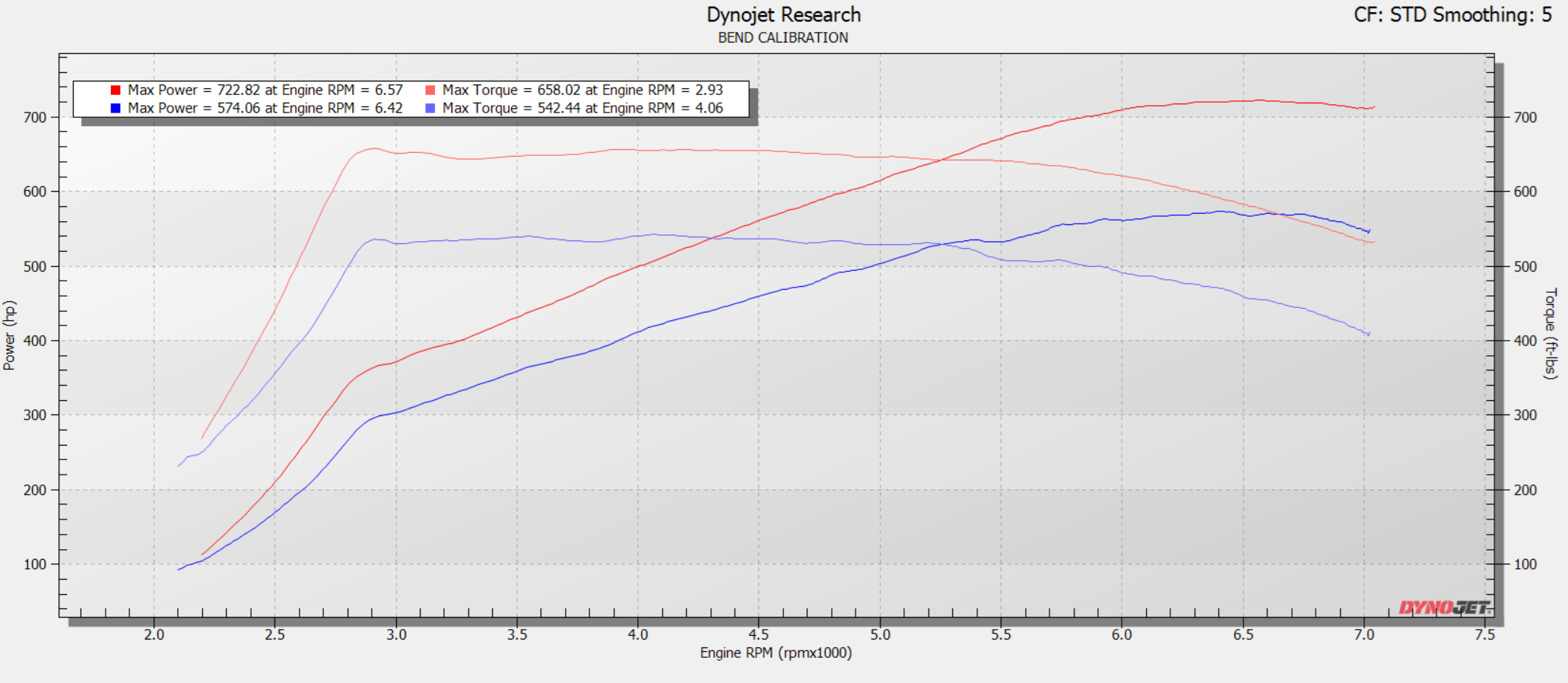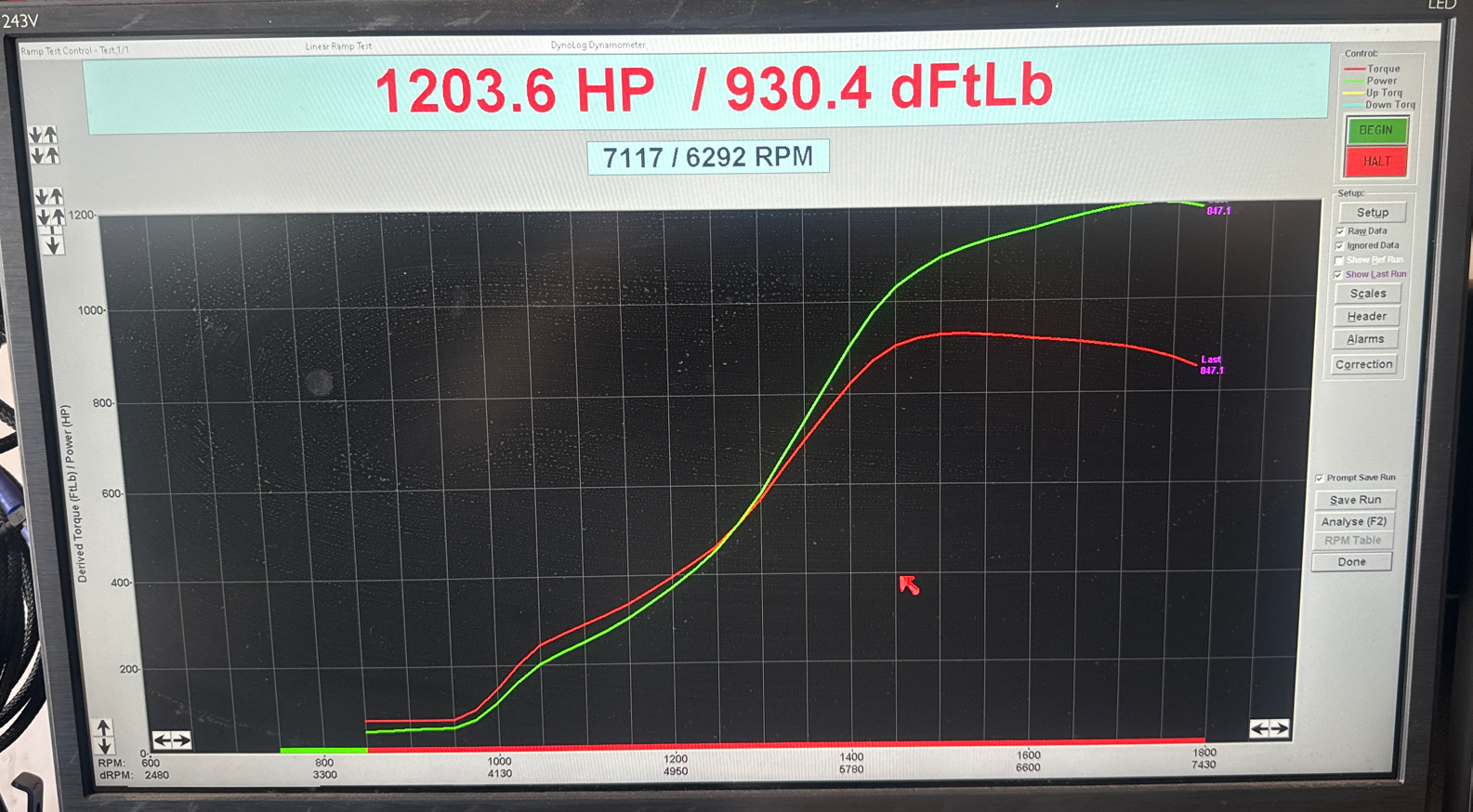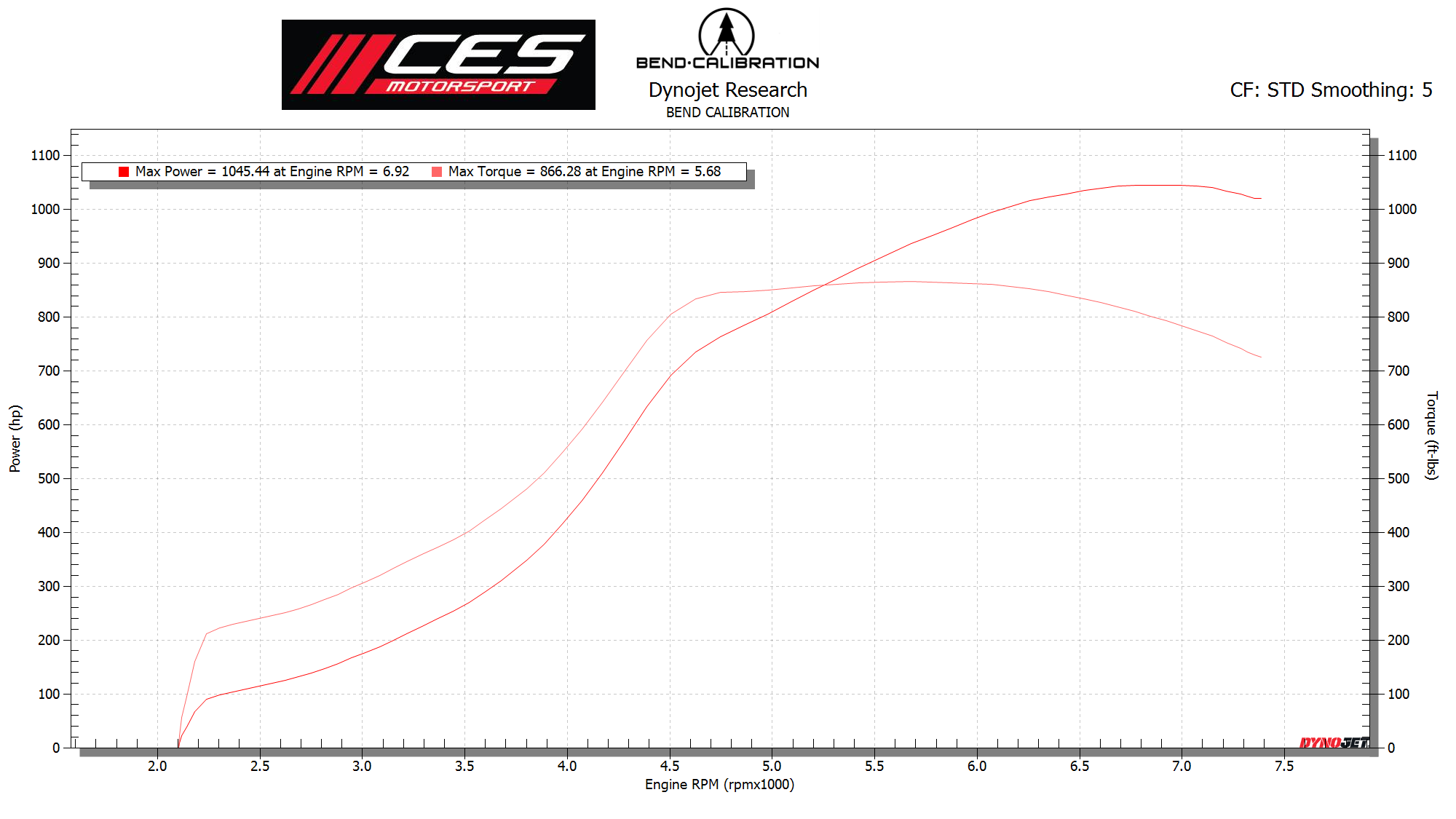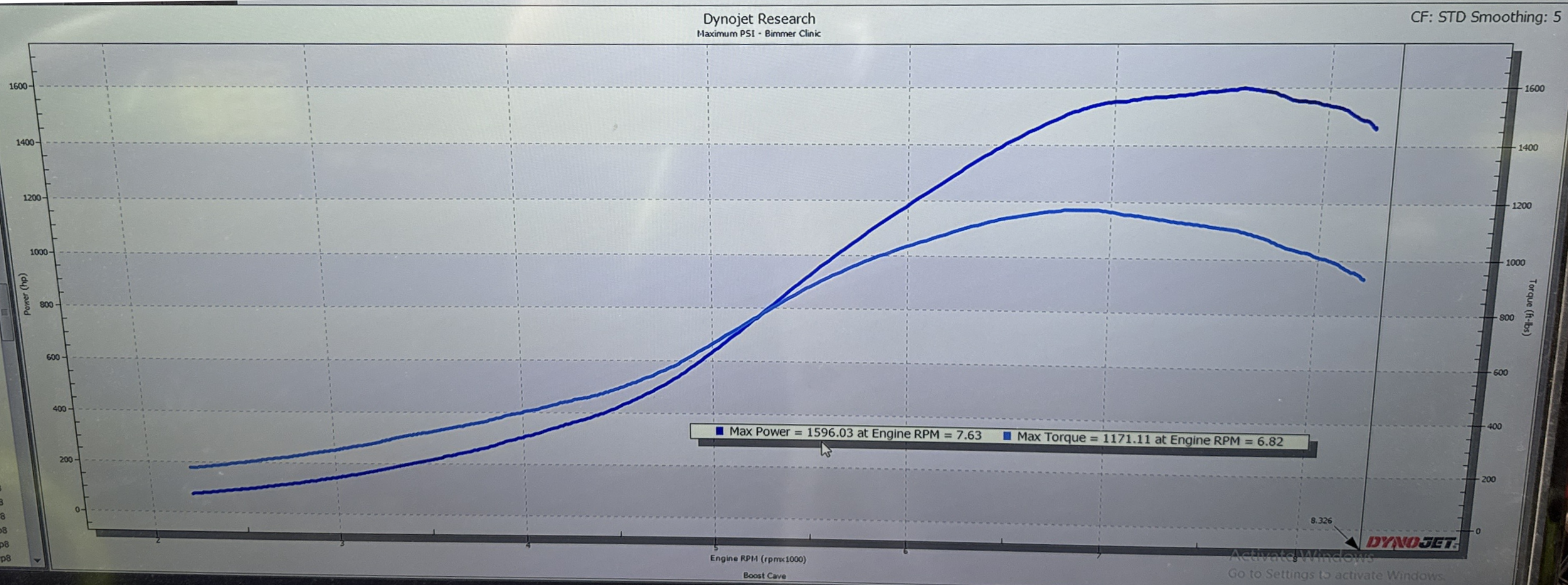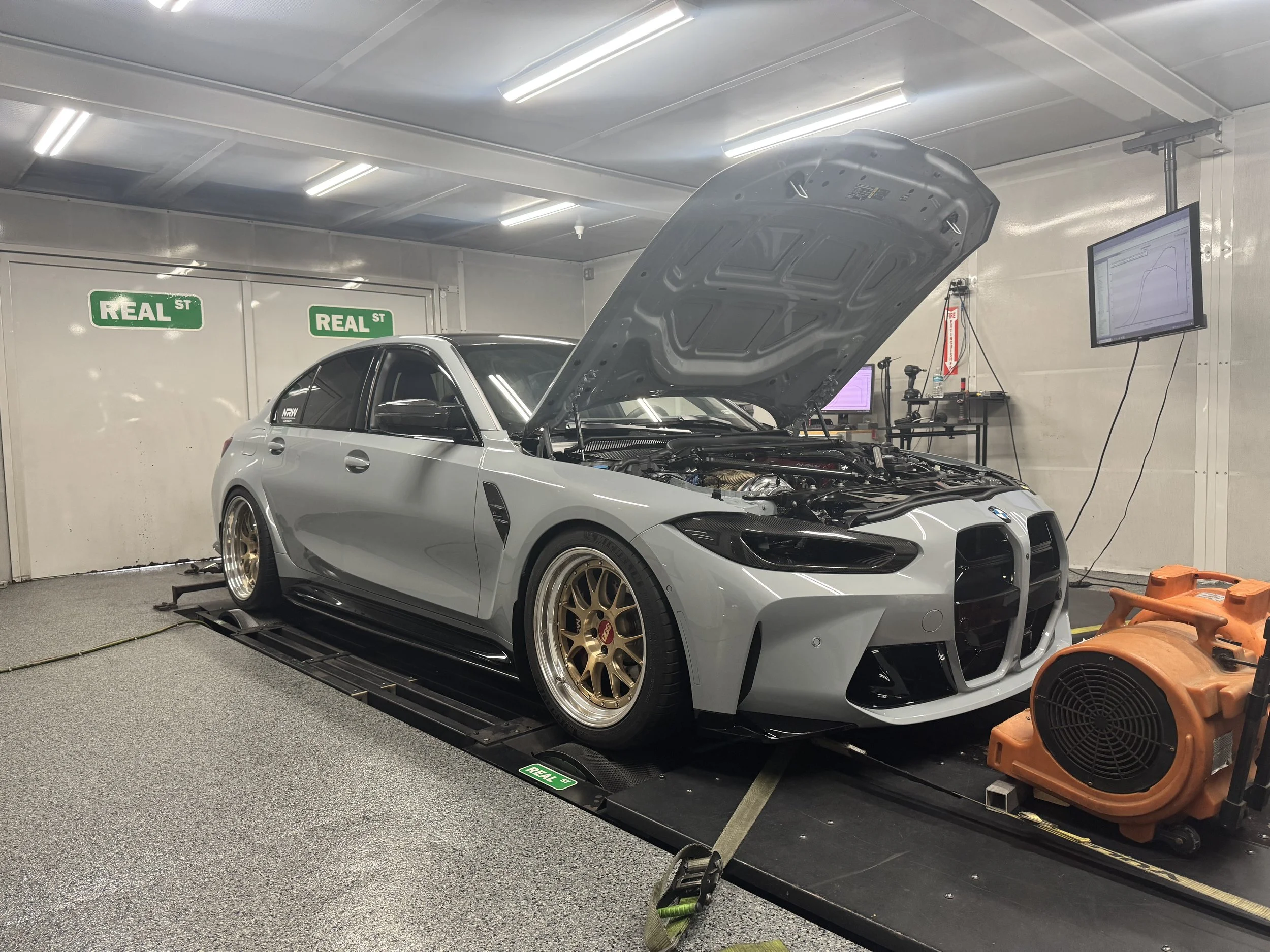S58 Build Path
In our opinion, the S58 is the best motor that’s come out of Bavaria in a long time. It combines the smooth power delivery of the B58 with the big power potential you’d expect from an M car and backs it all up with a robust AWD drivetrain. It also doesn’t have some of the weak points of earlier BMW Twin Power Motors.
Typical S58 on 93oct:
Above:
Red is Map2 on 93
Blue is Map1 on 93
This car has Eventuri intakes, 200cell dp's and Valvetronic full exhaust that we recently tuned on 93 on the East Coast
We setup all of our tuning with dual map switch on the fly options. This gives you a more conservative and more aggressive calibration at the touch of a button.
Another S58 on a different dyno also with 93 oct above.
Typical S58 on 91 California Fuel above.
Stock S58 add flex with direct injection only what can be expected:
Stock hardware and fuel system with flex fuel above.
Add Stage 1 bolt on parts:
Stock S58 with Stage 1 bolt on parts; not much difference in power from stock hardware. With the stock DI only fuel system, you can run any blend of pump gas to full E85 but it will max maximum power roughly at E50.
The above graph is a recent calibration of a stock engine/turbos S58, DI only, with PG front mount intakes, AFD exhaust. The green line is stock, blue is pump fuel tuning, and red is on E50. Both pump and E50 tuning leaves reasonable room on the table for real world variables.
The car is put together and managed by Maximum PSi/Bimmerclinic
MHD VS BM3 for Direct Injection only (No port injection), with flex fuel.
Due to how the blending works, the MHD blending is more sophisticated and allows for a broader, more adjustable powerband. Peak power on about E50 is the same between the two platforms. See the graphs below
BM3 Map 1 and Map 2 both make the same power when running ethanol fuels
MHD + allows for Map 1 and Map 2 to be entirely independent at all ethanol contents. We generally set up Map 1 for circuit/conservative and Map 2 for max effort as requested by client.
Move up to stage 2 bolt ons + port injection
There are 3 primary benefits when adding port injection to DI only vehicles:
You can run high ethanol >85% which has much higher octane than say a 50% ethanol blend.
We can run richer mixtures which are much safer than leaner combustion levels of DI only, max effort calibrations
More power as we can make up to 780whp when fully pushed on an optimal car with good air, good hardware, and good density altitude. Most cars typically in the 750whp range. Both of these numbers are risking rod bending on any calibration.
All three of the above advantages come with PI because the limitations of the stock DI system is alleviated by adding a PI system.
Move up to stage 2 + PI and you max out the turbos with the above graph. Port injection allows for safer fuel mixtures and full power at maximum ethanol content.
Another Stage 2 + PI shows that the turbos are maxing out around this power level. Variance from approximately this power level on a max effort calibration are within the margin of error, have better or worse ambient conditions, or a dyno that is reading differently from a standard dynojet at sea level.
Another Max Effort setup and the client picked up 50whp by swapping to a much better intake/exhaust setup. Previously had maxed out around 725whp.
Above is a stage 2 + PI on pump fuel (blue) and ethanol (red). Both calibrations are sensible and leave some room on the table for realistic variations in fuel and air quality. This calibration is similar to how we run our own personal cars.
Stock Engine/Trans
Stock Turbo
Stock Manifold
Reflex+ w/ ID1050x
Visconti Stage1 LPFP
Considerations worth considering
When running the stock DI (direct injection only) fuel system, maximum power is achieved in the E50-E60 range. There are a couple caveats worth mentioning when running a max effort stock fuel system tune: 1) Exhaust cam tracking may display some inconsistency. 2) Achieving these higher numbers requires running a leaner, more aggressive mixture.
Adding PI completely alleviates both of the above issues. It allows maximum power on full E95.
Downpipes: The stock downpipes can make 700+whp. The aftermarket downpipes tend to help with spool up but also add a lot of rasp/volume. They typically make same peak power numbers with/without upgraded downpipes.
When selecting a calibration platform
We tune S58 on Ecutek, BM3, and MHD. Ecutek is limited in what vehicles can be supported and may require a clone DME, which is expensive and a hassle. There are also CAN comm issues on F97/F98’s with PI.
Maximum Psi
BM3 or MHD +?
That leaves BM3 and MHD + which we have a lot of experience with. We can get good results with either of them up to stage 2 flex fuel vehicles.
This flow chart will help you choose which platform is the ideal fit for your setup.
If you’re running port injection…
If you’re running PI; there is only one way to go and that’s MHD + with fully integrated Reflex. This setup works great, and has full communication in two directions between the OEM DME and the Reflex which fires the PI injectors. It is critical that the duties for fueling are shared and that the right hand knows what the left hand is doing.
More detail from one of our calibrators:
“If you currently have BM3 and you’re wondering why we are suggesting moving to MHD+, the new release of MHD+ [for S58] brings integrated Port Injection that is an awesome tool available in our arsenal to dial in cars. With MHD+, they have integrated the control of the port injection directly from the DME; so the tuning we update in the factory DME directly controls all the fuel delivery; both port and direct.
BM3's current REV1.1 CustomROM software as an example only supports separate fueling from Port Injection. When running, for example, half of our total fuel by volume from port injection (Reflex non integrated), we must subtract 50% of the fuel from the direct injection tables in BM3. If the port injection didn’t inject for any reason, the direction injection side would not know, since it is not communicating. On MHD+ if something goes wrong with the port injection, the car would throw a code and go into limp mode to protect the car from running lean. “
The above is a visual example of what a fully integrated port injection control system looks like.
Wraps By Dre
Not only this, but the MHD support staff offer exemplary support for their products and development of their program.
Other relevant information
Please contact us for purchasing Wagner parts at great pricing.
Wagner G8x intake manifold with cooler
Wagner fuel rail with fitting 001002433.KKIT.S58
If sticking with the Factory Manifold, we recommend the PFS fuel rail setup which we don't sell.
Do88 cooler TBD (in testing)CSF works well on this platform
OEM intake manifold works but can fail under boost
OEM Heat exchangers are good; but PWR or Wagner if those are to be changed.
There’s no question on this one. See this article: Flow Balancing Injectors
What’s the next step?
We can do hybrid turbo setups and big singles upwards of 1400+ horsepower. The Mosselmans are a good first step if you’re going with Hybrids, or a 6870 single turbo kit from KLM if you want to go single. The sound and simplicity of tuning a single is worth consideration.
S58 Hybrid Turbo Upgrade Calibration Notes
MHD+ has some other benefits including and especially when running hybrid turbo upgrades. A hybrid turbo upgrade is a term that means “stock style turbos that are upgraded”. The name comes from the fact that they are a hybrid of OEM and aftermarket components.
We've tuned many of these hybrids and they are a bit more funky by comparison to other BMW engine hybrid turbo upgrades to dial in. At the top end of the compressor mapping, we encounter a specific airflow limit and we lose resolution and control of the wastegate, so the throttle can start to really intervene and try to control the power on the top end...MHD has solved this and scaled the airflow axis up so we can control this better; in addition they have a custom boost control strategy that works great; BM3 and Ecutek don't have this function.
Pure Hybrid Turbo
Reflex w/ Bosch 950cc
AA GESI Downpipes
Mikewho_G82
2024-9-24 update:
HPFP Upgrades
Regarding the FX350 injectors and Spool HPFP's; we may run into issues when tuning these and I'll try to explain very briefly. The HPFP's are driven by the exhaust cam and we've seen on all the S58's (and B58's) that when you push the HPFP's to their limits this puts more strain on the exhaust cam and the exhaust cam no longer tracks the target. The engine will make less power in the event that the exhaust cam does not follow our targets. So I don't expect us to be able to properly take advantage of the full power delivery of the upgraded HPFP's. We will continue to test and update on our results with this. The results you may see posted online by others may have cam tracking issues, HPFP pressure issues, or lean conditions in order to sell a product. Once we’ve verified we can accomplish the power goals we are after without compromise we will revise our stance on these.
The simple solution here is to run port injection which does not suffer from exhaust cam tracking issues.
Single Turbo Upgrades
Single turbo is best done on MHD+ for single bank + integrated Reflex + control.
To start, we recommend using stainless hard lines or well insulated soft lines (stainless braided does not insulate, use something like DEI + social distancing) to prevent melted wg hoses.
While we don’t want you to depend on it, we do however have some strategies employed that will chop the throttle to prevent overboosting (we don't disable this factory control) and it has saved a couple single turbo setups who had wastegate lines melt. Some calibrators disable all of this control and while that is easy, it is not the right way to dial in the car, in our opinion.
The flex fuel setup for single cars allows you to run any ethanol content from pump fuel to full E85, or anything in between. It has two modes, switch on the fly, and allows you to access multiple power levels at any time, while staying within the safe limits of the fuel quality you’re running. The ethanol content comes in via the Reflex +. No measuring and mixing, no fixed ethanol content calibrations, or any of that antiquated mentality on these modern marvels. There’s only one way to do this correctly, and that’s with everything seemlessly integrated.
One last consideration is that since we have our own S58 Single turbo, we have done extensive development on this specific combination. We are always improving our work; driveability is amazing and the control is the best in the business. We have thorough, well sorted, stable, reliable calibration strategies that are specific to the S58.
Stock Motor (Warning this can bend rods)
KLM 6870 Turbo Kit
4B Performance Custom Fuel Surge Tank
Do88 Manifold w/ ID1750x
KLM 11:1 Stroker
Vargas 6870 Straight E-Gate Turbo Kit
CSF Manifold, Reflex w/ ID1750x
AFS800 w/ Kaizen Relay Upgrade
S58 MaxPSI Built Motor
KLM 6870 Turbo Kit
Reflex+ w/ ID1700
MaxPSI Custom Fuel Surge Tank
The above graph are 4 available maps on Mike Wolfe’s Big Blue 2. It features a MaxPSI built motor, RK G40-1150 turbo kit, and supporting modifications.
Tinos’ car features a MaxPSI built motor, Doc Race 7275 Turbo kit, and supporting modifications.
Bend Calibration Tuned Maximum PSI G80.
NRW’s Beautiful G80 equipped with their very own built engine and turbo kit including a G42-1200C turbo; all the power for all the fun.












